Washington University in St. Louis
| Washington University in St. Louis | |
|---|---|
|
Latin: Universitas Washingtoniana |
|
| Motto: | Per veritatem vis |
| Motto in English: | Strength through truth |
| Established: | February 22, 1853 |
| Type: | Private |
| Endowment: | ▼U.S.$4.05 billion[1] ~U.S.$5.42 billion[2] |
| Chancellor: | Mark S. Wrighton |
| Faculty: | 3,140 |
| Staff: | 12,400 |
| Undergraduates: | 6,124 |
| Postgraduates: | 6,270[3] |
| Other students: | 1,227 part time students[3] |
| Location: | |
| Campus: | Urban and Suburban 2,335 acres (9.01 km²) Danforth Campus, 169 acres (0.7 km2) Medical Campus, 59 acres Tyson Research Center, 2,000 acres (8 km2) North Campus, 13 acres |
| Former names: | Eliot Seminary, Washington Institute |
| Colors: | Red and Green[4] |
| Nickname: | Wash U, WUSTL |
| Mascot: | Bears |
| Athletics: | NCAA Division III UAA 19 varsity teams as of Fall 2008 |
| Website: | www.wustl.edu |
Washington University in St. Louis is a nonsectarian, private research university located in Greater St. Louis, Missouri. Founded in 1853 and named for George Washington, the university has students and faculty from all fifty U.S. states and more than one hundred and twenty five nations.[5] Twenty-two Nobel laureates have been associated with Washington University, nine doing the major part of their pioneering research at the university.[5] Washington University is made up of seven graduate and undergraduate schools[6] that encompass a broad range of academic fields. Officially incorporated as The Washington University, popular nicknames for the university include Wash. U. and WUSTL, all derived from the initials of the university's name. To prevent confusion over its location, the Board of Trustees added the phrase "in St. Louis" in 1976.[7] The university has an endowment of $5.42 billion.[2] The current chancellor is Mark S. Wrighton, who has led the university since 1995. He is among the highest paid university heads in the United States.[8]
Contents |
History

Washington University was co-founded in 1853 as a nonsectarian, private institution by St. Louis leader Wayman Crow and the Unitarian minister William Greenleaf Eliot, grandfather of the Nobel Prize laureate poet T. S. Eliot. The University's original name at the time of its founding was Eliot Seminary. Eliot, however, was not in favor of the name, and in 1854, the Board of Trustees changed it to "Washington Institute in St. Louis" because the University's charter, was (by a historical coincidence) passed on Washington's birthday (February 22,1853) and Washington's name was free from any divisiveness.[7]
In 1857, the name was changed to Washington University. To avoid confusion with over 23 other institutions sharing the Washington name in their titles, the university again restored the "in St. Louis" suffix in 1976 to distinguish it in the international media.
Fitting for its national prominence gained since World War II, Washington University has been known to be a progressive campus, frequently inviting speakers such as NAACP Chairman Julian Bond, who received an honorary doctorate in 2000.[9] Washington University admitted its first women law students in 1869.[10] Washington University School of Medicine later admitted its first women medical students in 1918.[11] Washington University integrated St. Louis Jewish Hospital, a local pioneering institution, as a major affiliate in 1963.[12] The process of desegregation at Washington University began after World War II in 1947 with the School of Medicine and the School of Social Work followed by all undergraduate programs in 1952.[13]
Rankings and reputation
In 2007, Washington University received 22,428 applications for 1,338 Class of 2011 positions.[14] The acceptance rate for the Class of 2011 was 19%. More than 90% of incoming freshmen were ranked in the top 10% of their high school class. Also in 2006, the University ranked fourth overall and second amongst private universities in the number of enrolled National Merit Scholar freshmen, according to the National Merit Scholar Corp.'s annual report.[15] Washington University in St. Louis was ranked number one for quality of life in 2008 according to the Princeton Review, among other top rankings.
Currently, the undergraduate program is ranked 12th overall, tied with Northwestern University, and 11th in admissions selectivity, in the 2009 U.S. News & World Report National Universities ranking.[16] Additionally, 19 undergraduate disciplines are ranked among the top 10 programs in the country.[17] Global rankings include 28th in a ranking of world universities by Shanghai Jiao Tong University in 2006 that assesses quality of scientific research leading toward a Nobel Prize.[18] Britain's Times Higher Education Supplement ranked Washington University 48th in the world in 2006.[19] Washington University was ranked 45th nationally in The Washington Monthly's 2006 ranking of universities' contributions to research, community service, and social mobility.[20] In addition, the Olin Business School's undergraduate program is among the top 12 in the country.[21] The Olin Business School's undergraduate program is also considered amongst the country's most competitive, admitting only 14% of applicants in 2007.[22]
Graduate schools include the School of Medicine, currently ranked 3rd in the nation, and the George Warren Brown School of Social Work, currently ranked 1st. In 2008-2009, the School of Law was ranked 19th while the Olin Business School was ranked 25th.[23] Additionally, the Graduate School of Architecture and Urban Design was ranked 5th in the nation by Design Intelligence.
Geography
Although the school includes St. Louis in its name – and its official mailing address is St. Louis – the school's main Danforth Campus including Brookings Hall and its most famous landmark pertrusions, are actually in an unincorporated section of St. Louis County just west of the St. Louis City limits across Skinker Boulevard from Forest Park (St. Louis). Its eastern border is the city of St. Louis. It is bordered to the north and northwest by the city of University City, Missouri, and to the south and southwest by Clayton, Missouri.
The school's Medical Campus is in the city of St. Louis on the east end of Forest Park. Some administrative offices are in the city of St. Louis in what is called the North Campus. The 560 Music Center and the Lewis Center are in University City.
The school has also two smaller campuses (South and West) as well as the Tyson Research Center in St. Louis County.
United States Presidential and Vice Presidential debates
Washington University is well known for hosting United States Presidential and Vice Presidential debates. The University has been selected to host a Presidential or Vice Presidential debate in every United States Presidential election since 1992. United States presidential election debates were held at the Washington University Field House in 1992, 2000, and 2004. A Presidential debate was planned to occur in 1996, but scheduling difficulties between the candidates canceled the debate.[24] The university hosted the only 2008 Vice Presidential debate, between Governor Sarah Palin, R-AK, and Senator Joe Biden, D-DE, on October 2, 2008, also at the Washington University Field House.
Although Chancellor Wrighton has previously noted after the 2004 debate that it would be "improbable" that the University will host another debate and was not eager to commit to the possibility,[25] he subsequently changed his view and the University submitted a bid for the 2008 debates. "These one-of-a-kind events are great experiences for our students, they contribute to a national understanding of important issues, and they allow us to help bring national and international attention to the St. Louis region as one of America's great metropolitan areas," said Wrighton.[26]
Campuses
Danforth Campus
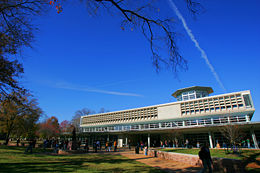
Distinguished by its collegiate gothic architecture, the 169-acre (0.7 km2) Danforth Campus lies at the western boundary of Forest Park, partially in the City of St. Louis. Most of the campus sits in unincorporated St. Louis County, while the southern part of the campus sits in suburban Clayton.
Formerly known as the Hilltop Campus, Danforth Campus was officially dedicated with a formal university ceremony on September 17, 2006, in honor of William H. Danforth, the 13th Chancellor of the University, the Danforth family, and the Danforth Foundation.
The construction of Danforth Campus was accelerated through a profitable lease of several buildings to the 1904 St. Louis World's Fair. Through the efforts and influence of David R. Francis, an alumnus and former mayor of St. Louis, Missouri governor and U.S. Interior Secretary, newly-constructed campus buildings on the edge of Forest Park began use for classes when the World's Fair was over. This included facilities used by the 1904 Summer Olympics (the first Olympics played in the Western Hemisphere), such as Francis Field and Francis Gymnasium.[27]
The Danforth Campus is accessible by the University City-Big Bend and Skinker stations on the MetroLink's recently-opened cross-county extension, which provides easy access to the Washington University Medical Campus, the North Campus, and the West Campus.
Medical Campus
Washington University Medical Center comprises 135 acres (0.5 km2) spread over approximately 12 city blocks, located along the eastern edge of Forest Park within the Central West End neighborhood of St. Louis. The campus is home to the School of Medicine and its associated teaching hospitals, Barnes-Jewish Hospital and St. Louis Children's Hospital. Many of the buildings are connected via a series of sky bridges and corridors.
The School's 2,100 employed and volunteer faculty physicians also serve as the medical staff of Barnes-Jewish and St. Louis Children's hospitals, which are part of BJC HealthCare. Washington University and BJC have taken on many joint venture projects, such as the Center for Advanced Medicine, completed in December 2001.
Olin Residence Hall, named for Spencer T. Olin, provides residential services for 200 medical and graduate students.[28]
The Medical Campus is accessible via the Central West End MetroLink station, which provides a quick link to the Danforth, North, and West Campuses.
Medical Campus Includes:
- Barnes-Jewish Hospital
- Central Institute for the Deaf
- St. Louis Children's Hospital
- Rehabilitation Institute of Saint Louis
- Siteman Cancer Center
- Center for Advanced Medicine
- Eric P. Newman Education Center (conference and convention center)
North and West campuses
Washington University's North Campus and West Campus principally house administrative functions that are not student-focused. North Campus lies in St. Louis City, near the Delmar Loop. The University acquired the building and adjacent property in 2004, formerly home to the Angelica Uniform Factory.[29] Several University administrative departments are located at the North Campus location, including offices for Quadrangle Housing, Accounting and Treasury Services, Parking and Transportation Services, Army ROTC, and Network Technology Services. The North Campus location also provides off-site storage space for the Performing Arts Department. Renovations are still ongoing; the most recent addition to the North Campus space was a small eatery operated by Bon Appétit Management Company, the University's on-campus food provider, completed during spring semester 2007.
The West Campus is located about a mile to the west of the Danforth Campus in Clayton, Missouri, and primarily consists of a three-story former department store building housing mostly administrative space. The West Campus building was home to the Clayton branch of the Famous-Barr department store until 1990, when the University acquired the property and adjacent parking and began a series of renovations.[30] Today, the basement level houses the Library archives and a conference center. The ground level still remains a retail space. The upper floors consolidated capital gifts, portions of alumni and development, and information systems offices from across the Danforth and Medical School campuses. There is a music rehearsal room on the second floor where the WUSTL Symphony Orchestra currently practices. The West Campus is also home to the Center for the Application of Information Technologies (CAIT), which provides IT training services.
Both the North and West Campuses are accessible by the St. Louis MetroLink, with the Delmar Loop and Forsyth MetroLink Stations directly adjacent to these campuses, which provides easy access around the St. Louis metropolitan area, including all of Washington University's campuses.
Tyson Research Center
Tyson Research Center is a 2,000-acre (8 km2) field station located west of St. Louis on the Meramec River. Washington University obtained Tyson as surplus property from the federal government in 1963. It is used by the University as a biological field station and research/education center.
Academics
| Undergraduate and Graduate Programs | Graduate and Professional |
|---|---|
Danforth Campus
|
Danforth Campus
Medical Center
|
Arts & Sciences
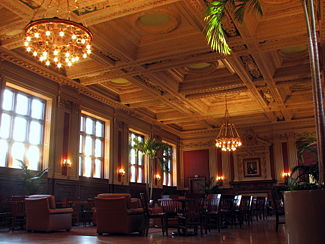
Arts & Sciences at Washington University comprises three divisions: the College of Arts & Sciences, the Graduate School of Arts & Sciences, and University College in Arts & Sciences. Edward S. Macias is Executive Vice Chancellor and Dean of Arts & Sciences. James E. McLeod is the Vice Chancellor for Students and Dean of the College of Arts & Sciences. Robert E. Thach is Dean of the Graduate School of Arts & Sciences.
- The College of Arts & Sciences is the central undergraduate unit of the University with 330 tenured and tenure-track faculty along with over 100 research scientists, lecturers, artists in residence, and visitors serving more than 3,700 undergraduates in 40 academic departments divided into divisions of Humanities, Social Sciences, and Natural Sciences and Mathematics.
- The Graduate School serves over 1,800 students pursuing Master's and Ph.D. degrees.
- University College at Washington University in St. Louis grants both graduate and undergraduate degrees, offering courses primarily in the evenings for adult and continuing education.
- The College of Arts & Sciences offers courses in over a dozen languages, including Arabic, Hebrew, Spanish, German, French, Swahili, Chinese, Japanese, Korean, Russian, Greek, Italian, Hindi, and Latin. University College in Arts & Sciences also offers course work in Swedish, Vietnamese, and Portuguese.
Business
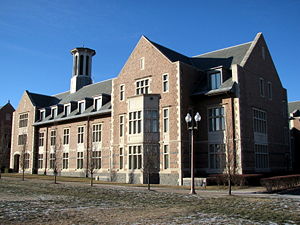
Founded as the School of Commerce and Finance in 1917, the Olin Business School was named after entrepreneur John M. Olin in 1988. The school provides degree programs including BSBA, MBA, MS in Finance, Master's in Accounting, part-time Professional MBA, Executive MBA and PhD, as well as non-degree executive education. In 2002, an Executive MBA program was established in Shanghai, in cooperation with Fudan University.
Olin has a network of about 15,000 alumni worldwide. Over the last several years, the school’s endowment has increased to $213 million (2004) and annual gifts average $12 million per year. Simon Hall was opened in 1986 after a donation from John E. Simon.
Undergraduate BSBA students take 40–60% of their courses at Olin and are able to formally declare majors in eight areas: accounting, entrepreneurship, finance, healthcare management, marketing, managerial economics and strategy, organization and human resources, international business, or operations and supply chain management. Graduate students are able to pursue the MBA degree either full-time or part-time. Students may also take elective courses from other areas in Washington University including law and many other fields. Mahendra R. Gupta is the Dean of the Olin Business School.
Olin graduates are well represented in leadership positions at companies across various industries, including: Wachovia, Anheuser-Busch, Bank of America, Bear Stearns, Deloitte Consulting, Edward Jones Investments, Exxon-Mobil, General Mills, IBM, International Paper, Marriott, Monsanto, JPMorgan Chase, Samsung, and UBS.
Design & Visual Arts
Created in 2005 by merging the existing Colleges of Art and Architecture, the Sam Fox School of Design & Visual Arts combines the strengths of these fields into a single collaborative unit offering both undergraduate and graduate programs. The School comprises:
- College of Architecture
- Graduate School of Architecture & Urban Design
- College of Art
- Graduate School of Art
- Mildred Lane Kemper Art Museum, considered one of the most distinguished university art collections in the country
Architecture offers BS and BA degrees as well as M. Arch and MUD. There is a combined six-year BS and M. Arch degree program as well as joint M. Arch programs with most of the other schools in the University. In 2008, the Graduate School of Architecture and Urban Design was ranked 5th in the nation by Design Intelligence.
Art offers the BFA and MFA in Art in the context of a full university environment. Students take courses in the College of Arts & Sciences as well as courses in the College of Art to provide a well rounded background. One third of students in the school pursue a combined study degree program, second major, and/or minors in other undergraduate divisions at Washington University. U.S. News & World Report ranked the MFA program 15th in the nation in 2008.[31]
In October 2006 the Mildred Lane Kemper Art Museum moved into new facilities designed by Pritzker Prize-winning architect, and former faculty member, Fumihiko Maki.
Carmon Colangelo is the Dean of the Sam Fox School of Design & Visual Arts. Bruce Lindsey is Dean of the College of Architecture and the Graduate School of Architecture & Urban Design. Ron Leax is the interim Dean of the College and Graduate School of Art.
Engineering
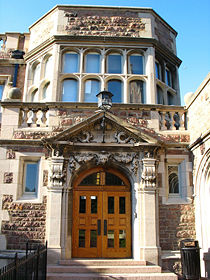
The Washington University School of Engineering was ranked 43 in the 2007–2008 U.S. News undergraduate engineering program ratings. Graduate programs are also offered through the School of Engineering and part-time programs through the Sever Institute of Continuing Studies. Its current head is Dean Mary J. Sansalone until July 2008. Interim Dean of Engineering Salvatore P. Sutera takes office 1 July 2008.
Departments include:
- Biomedical Engineering
- Computer Science and Engineering
- Electrical and Systems Engineering
- Energy, Environmental, and Chemical Engineering- will be housed in 2010 in the new Brauer Hall building, named after Hunter Engineering Company CEO and former Ambassador to Belgium Stephen F. Brauer and his wife Camilla
- Mechanical, Aerospace, and Structural Engineering
(In summer 2007, Civil Engineering and Mechanical and Aerospace Engineering were merged into the new Mechanical, Aerospace, and Structural Engineering Department.)
Law
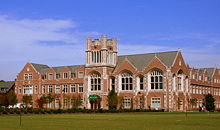
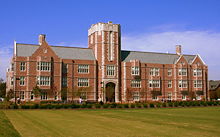
The Washington University School of Law offers eight joint-degree programs, including JD/MSW, JD/East Asian Studies, and JD/MBA programs. It also offers two graduate degrees in law, the LLM and the MJS (Master of Juridical Studies). The law school offers 3 semesters of courses in the Spring, Summer, and Fall, and requires at least 85 hours of coursework for the JD.
In the 2009 US News & World Report America's Best Graduate Schools, the law school is ranked 19th nationally, out of 190 law schools.[32] In particular, its Clinical Education Program is currently ranked 4th in the nation.[33] This year, the median score placed the average student in the 96th percentile of test takers.[34] The law school offers a full-time day program, beginning in August, for the J.D. degree. The law school is located in a state-of-the-art building, Anheuser-Busch Hall (opened in 1997). The building combines traditional architecture, a five-story open-stacks library, an integration of indoor and outdoor spaces, and the latest wireless and other technologies. National Jurist ranked Washington University 4th among the "25 Most Wired Law Schools."
Kent D. Syverud is the Dean of the School of Law.
Medicine
The Washington University School of Medicine is highly regarded as one of the world's leading centers for medical research and training.[35] Among its many recent initiatives, the School's Genome Sequencing Center (directed by Dr. Richard K. Wilson, Ph.D.) played a leadership role in the Human Genome Project, having contributed 25% of the finished sequence.[36] The School pioneered bedside teaching and led in the transformation of empirical knowledge into scientific medicine. The medical school partners with St. Louis Children's Hospital and Barnes-Jewish Hospital (part of BJC HealthCare), where all physicians are members of the school's faculty.
Within the medical school, the Program in Physical Therapy is also highly reputable. It is ranked 2nd in the nation for "Best Physical Therapy Schools" according to U.S. News & World Report.[37] In 1999, the Program was granted approval by Washington University to offer a Doctor of Physical Therapy (DPT) at both the professional and post-professional levels. The two new clinical doctorate programs replaced the Master of Science in Physical Therapy and the Master of Health Science (MHS). With the transition to the DPT, the program would best equip students to manage the changing needs of the health-care environment and the growing responsibilities of the profession. In its 60-year history, more than 1,500 students, most of whom are still actively involved in the physical therapy profession, have graduated from the Program.
The Program in Occupational Therapy is currently tied for 1st in the nation for "Best Occupational Therapy Schools" according to U.S. News & World Report.[38] The Program offers a Master of Science degree as well as the Occupational Therapy Doctorate (OTD) at the professional and post-professional levels. M. Carolyn Baum, Ph.D., serves as the program director and was the most recent president of the American Occupational Therapy Association (AOTA).
Larry Shapiro, MD, is Executive Vice Chancellor for Medical Affairs and Dean of the School of Medicine.
Social Work
The George Warren Brown School of Social Work (commonly called the Brown School or Brown) is currently ranked first among Master of Social Work (MSW) programs in the United States.[39] Brown also offers a Ph.D. in Social Work, in cooperation with the Graduate School of Arts & Sciences. The school was endowed by Bettie Bofinger Brown and named for her husband — George Warren Brown — a St. Louis philanthropist and co-founder of the Brown Shoe Company. The school is housed within Brown and Goldfarb halls. It has a center for Native American research, as well as acclaimed scholars in social security, health, individual development accounts, etc.
The school's current dean is Edward F. Lawlor.
Museums and library system
With 14 libraries, the Washington University library system is the largest in the state of Missouri, containing over 3.7 million volumes.[40] The main library, Olin Library, is centrally located on the Danforth Campus. Other libraries in the system include:
- Kranzberg Art & Architecture Library
- Biology Library
- Business Library
- Chemistry Library
- East Asian Library
- Law Library
- Mathematics Library
- Medical Library (Becker)
- Music Library
- Physics Library
- Social Work Library
- Special Collections & Archives
- West Campus Library
The Mildred Lane Kemper Art Museum, established in 1881, is one of the oldest teaching museums in the country and the first art museum established west of the Mississippi River. The collection includes works from 19th, 20th, and 21st century American and European artists, including George Caleb Bingham, Thomas Cole, Pablo Picasso, Max Ernst, Alexander Calder, Jackson Pollock, Rembrandt, Robert Rauschenberg, Barbara Kruger, and Christian Boltanski. Also in the complex is the 3,000 sq ft (300 m2) Newman Money Museum. In October 2006, the Kemper Art Museum moved from its previous location, Steinberg Hall, into a new facility designed by Fumihiko Maki. Interestingly, Maki's very first commission was in fact that very same Steinberg Hall on Washington University's campus in 1959, which is directly in front of his newest building, the Kemper Art Museum complex, nearly 40 years after Steinberg.
Research, Research Centers and Institutes
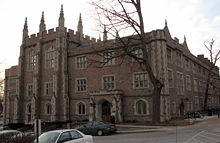
Virtually all faculty members at Washington University engage in academic research, offering opportunities for both undergraduate and graduate students across the University's 7 schools. Known for its interdisciplinarity and departmental collaboration, most research centers and institutes at Washington University are collaborative efforts between many areas on campus. More than 60% of undergraduates are involved in faculty research across all areas;[41] it is an institutional priority for undergraduates to be allowed to participate in advanced research, which is rather unique among leading private research universities.[42] According to the Center for Measuring University Performance, it is considered to be one of the top 10 private research universities in the nation.[43] A dedicated Office of Undergraduate Research is located on the Danforth Campus and serves as a resource to post research opportunities, advise students in finding appropriate positions matching their interests, publish undergraduate research journals, and award research grants to make it financially possible to perform research.[44]
During fiscal 2007, $537.5 million was received in total research support, including $444 million in federal obligations. The University has over 150 National Institutes of Health funded inventions, with many of them licensed to private companies. Governmental agencies and non-profit foundations such as the NIH, United States Department of Defense, National Science Foundation, and NASA provide the majority of research grant funding, with Washington University being one of the top recipients in NIH grants from year-to-year. Nearly 80% of NIH grants to institutions in the state of Missouri went to Washington University alone in 2007.[45] Washington University and it's Medical School play a large part in the Human Genome Project, where it contributes approximately 25% of the finished sequence.[46] The Genome Sequencing Center has decoded the genome of many animals, plants, and cellular organisms, including the platypus, chimpanzee, cat, and corn.[47]
NASA hosts its Planetary Data System Geosciences Node on the campus of Washington University. Professors, students, and researchers have been very involved with many unmanned missions to Mars. Professor Ray Arvidson has been co-investigator of the Phoenix Rover robotic arm and chair of the Mars Exploration Rover landing site group.[48]
Washington University professor Joel Lowenstein, with the assistance of several undergraduate students, has been involved in editing, annotating, making a digital archive of the first publication of poet Edmund Spencer's collective works in 100 years. A large grant from the National Endowment for the Humanities has been given to support this ambitious project centralized at Washington University with support from other colleges in the United States.[49]
Campus life
Student organizations
Washington University has over 200 undergraduate student organizations on campus.[50] Most are funded by the Washington University Student Union, which has a $2 million plus annual budget that is completely student controlled and is one of the largest student government budgets in the country. Known as SU for short, it sponsors large-scale campus programs including WILD (a semesterly concert in the quad), free copies of the New York Times, USA Today, and the St. Louis Post-Dispatch through The Collegiate Readership Program; the Assembly Series, a weekly lecture series; and the campus television station, WUTV and the radio station, KWUR. KWUR was named best radio station in St. Louis of 2003 by the Riverfront Times despite the fact that its signal reaches only a few blocks beyond the boundaries of the campus.[51] Washington University is also home to the National Prestigious Society of Collegiate Jugglers, one of the largest and most talented juggling clubs in the Midwest. There are 11 fraternities and 6 sororities. The Congress of the South 40 (CS40 for short) is a Residential Life and Events Programming Board, which operates outside of the SU sphere. CS40's funding comes from the Activities Fee of each student.
Many of these organizations and other campus life amenities will be housed in the new $41 million Danforth University Center being built on the Danforth Campus, also to be dedicated in honor of the Danforth family. The building will be completed by Fall 2008 and is expected to earn a LEED rating of Gold for environmentally friendly design.
ASSWA - African Students of Social Work Association is one of the most vibrant student organization in campus.
Residences
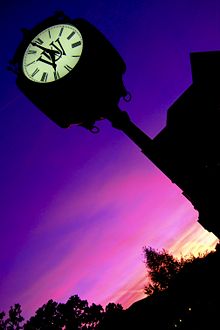
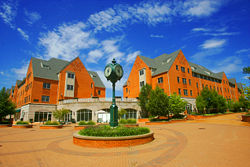
75% of undergraduate students live on campus. Most of the residence halls on campus are located on the South 40, named because of its adjacent location on the south side of the Danforth Campus and its size of 40 acres. It is the location of all the freshman dorms as well as several upperclassman dorms. All of the dorms are co-ed. The South 40 is organized as a pedestrian-friendly environment where residences surround a central recreational lawn known as the Swamp. Wohl Student Center, the Habif Health and Wellness Center (Student Health Services), the Residential Life Office, University Police Headquarters, various student-owned businesses (e.g. the laundry service, Wash U Wash), and the baseball, softball, and intramural fields are also located on the South 40.
Another group of residences, known as the North Side, is located in the northwest corner of Danforth Campus. Only open to upperclassmen and January Scholars, the North Side consists of Millbrook Apartments, The Village, Village East (to open fall 2008), and all fraternity houses except the Zeta Beta Tau house, which is off campus and located just northwest of the South 40. Sororities at Washington University do not have houses by their own accord. The Village is a group of residences where students who have similar interests or academic goals apply as small groups of 4 to 24, known as BLOCs, to live together in clustered suites. Like the South 40, the residences around the Village also surround a recreational lawn.
Student media
Washington University supports four major student-run media outlets. The university's student newspaper, Student Life, is available for students. KWUR (90.3 FM) serves as the students' official radio station; the station also attracts an audience in the immediately surrounding community due to its eclectic and free-form musical programming. Though KWUR offers streaming content through the Internet, the station only broadcasts at 10 watts,[51] and its frequent applications to the FCC to increase its power have been unsuccessful. WUTV is the university's closed-circuit television channel. The university's main student-run political publication is the Washington University Political Review (nicknamed "WUPR"), a self-described "multipartisan" triweekly magazine. Washington University undergraduates publish two literary and art journals, The Eliot Review and Spires Intercollegiate Arts and Literary Magazine. A variety of other publications also serve the university community, ranging from in-house academic journals to glossy alumni magazines to Wunderground, campus' student-run satirical newspaper.
Athletics
WUSTL's sports teams are called the Bears. They participate in the University Athletic Association and the NCAA Division III. The Bears have won 15 NCAA Division III Championships, one each in men's tennis (2008) and basketball (2008), four in women's basketball (1998-2001),[52] nine in women's volleyball (1989, 1991-1996, 2003, 2007),[53] and 122 UAA titles in 14 different sports.[54] The Athletic Department is headed by John Schael who has served as director of athletics since 1978. The 2000 Division III Central Region winner of the National Association of Collegiate Directors of Athletics/Continental Airlines Athletics Director of the Year award,[55] Schael has helped orchestrate the Bears athletics transformation into one of the top departments in Division III.[56] Washington University in St. Louis is home of Francis Field, site of the 1904 Summer Olympics. Francis Field is also home of the Washington University in St. Louis Football, Soccer, and Track and Field teams.
- WUSTL women's volleyball team has enjoyed Division III national champions in 1989, 1991, 1992, 1993, 1994, 1995, 1996, 2003, 2007. In 2007 the Bears defeated University of Wisconsin-Whitewater in the Championship game and finished the season 33-5.[57]
- In Men's Basketball WUSTL won the national championship in 2008, defeating Amherst 90-68. WUSTL lost to Virginia Wesleyan College in the 2007 NCAA Final Four, but defeated Wooster in the third place game. Junior forward Troy Ruths earned first-team All-America honors by DIII News, third-team accolades by the NABC, and honorable-mention honors by D3hoops.com. Freshman guard Aaron Thompson was named to the DIII News All-Freshman Team.[58]
- The women's Basketball team won four consecutive national titles from 1998-2001. In 2007 both the men's and women's teams made the Final Four. The women lost to DePauw in the title game.[59]
- Having made 17 NCAA Tournament appearances, the WUSTL's men's soccer program is one of the nation's most storied. Since the inception of the Division III tournament in 1974, the Bears have finished as national runners-up three times (1978, 1985, 1987). The Bears have also posted a 22-16-4NCAA Tournament record (.585). The Bears have endured just three losing seasons out of the last 18, and none since 1994. Washington University has a 193-91-26 (.665) record over that span, including five NCAA Tournament appearances, two University Athletic Association (UAA) titles and a Division III Final Four appearance in 1997.[60]
- The women's soccer team has made seven NCAA appearances and captured five UAA Championships. The current Head Coach is Wendy Dillinger.
- The Swimming and Diving teams are led by eight year head coach Brad Shively. In 2005-2006, Shively led the Red and Green to their top finishes in program history. The women placed fifth at the NCAA Championships, while the men took sixth. Additionally, Seniors Michael Slavik (24-time All-American) and Eric Triebe (26-time All-American) won the first (50 free - 20.46 Michael Slavik) and second (200 free - 1:39.12 Eric Triebe) individual national titles in Washington University history.[61] Since 1979, 56 Bears student-athletes have earned 304 All-America citations. Additionally, the women's team has produced a composite dual meet record of 165-57, while the men's team has compiled a 144-90 mark.[62]
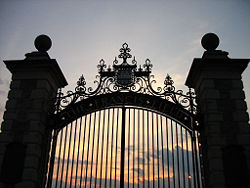
- The cross-country teams are managed by head coach Jeff Stiles. The women placed third at the 2007 NCAA Division III Championship meet. The Bears also ran to third-place finishes at the 2005 and 2004 NCAA Division III Championships. Washington U. came in fourth place at the 2006 NCAA Championships. The women also won their third-straight Midwest Region title in 2007. In 2006, the men qualified for the NCAA Championships for the first time since 1997 and the fourth time overall. All told, the men's and women's cross country teams have won 12 UAA titles (eight women, four men), qualified as a team for the NCAA Championships 10 times (six women, four men) and sent 32 individual qualifiers to the Championships. Since 1997, the Bears have also produced 10 All-Americans; seven individuals have combined to total All-America 11 honors.
- Since the inception of the Washington University softball program in 2000, the team has captured five UAA championships and has made six consecutive trips to the NCAA Tournament, including its 2007 College World Series runner-up finish.[63]
- The men's roller hockey team has made the NCRHA national tournament in consecutive years from 2005–2008, finishing as high as 3rd in the nation for Division II in 2005.[64]
Traditions
- WILD - Walk In, Lay Down, the semesterly concert in the Quad which brings in popular acts such as Guster, Lil' Jon, Ben Folds, Busta Rhymes, Live, and the Black Eyed Peas.
- Bauhaus - Annual Halloween costume party sponsored by the Architecture Student Council, held in a giant tent in front of Givens Hall.
- Thurtene Carnival - The oldest and largest student-run carnival in the nation, run by Thurtene Honorary.[65]
- Vertigo - A dance party put on by the Engineering School Council (EnCouncil), featuring an innovative 8-foot by 16-foot computer-controlled modular LED illuminated dance floor built by students. The dance floor has since become a hit in St. Louis.
- Cultural Shows - Washington University student groups put on several multicultural shows held each year, one of which sells out within hours of tickets going on sale (Diwali). Ashoka, the South Asian student association, puts on a performance for Diwali, the Indian festival of lights, that includes a skit and dances; Black Anthology is a student-run performance arts show celebrating black culture; Lunar New Year Festival is a collaboration between the many East Asian organizations on campus culminating in a show to celebrate the holiday with a skit and dances from Chinese, Japanese, and Korean cultures; the Association of Latin American Students showcases various forms of Latin and Spanish dances during their performance, Carnaval.
Chancellors
Since its founding, Washington University has been led by 14 Chancellors, beginning with Joseph Gibson Hoyt in 1858. Mark Stephen Wrighton serves as the current Chancellor of the University.
Notable people
- List of Washington University alumni
- List of Washington University faculty and staff: economist and Nobel Memorial Prize winner Douglass North; husband and wife biochemists and co-Nobel Prize winners Carl and Gerty Cori; physicist and Nobel Prize winner Arthur Holly Compton; novelists Stanley Elkin and William Gass; poet Carl Phillips; neurologist and Nobel Prize winner Rita Levi-Montalcini; sex researchers William Masters and Virginia Johnson; Poet Laureates Howard Nemerov and Mona Van Duyn; sociologist and "outlaw Marxist" Alvin Ward Gouldner; attorney, former Counsel to Vice-President Al Gore and former Tennessee Attorney General Charles Burson; writer and culture critic Gerald Early; Economist, and former Chair of President Ronald Reagan's Council of Economic Advisors, Murray Weidenbaum; chemist Joseph W. Kennedy, co-discoverer of the element plutonium; computer scientist Jonathan S. Turner, internationally renown expert in computer networking.
Grammy award winning viola player Mitchell Stumpf
Further reading
- Ralph E. Morrow, Washington University in St. Louis: A History St. Louis: Missouri Historical Society Press, 1996.
- Candace O'Connor, Beginning a Great Work: Washington University, 1853-2003 St. Louis: Washington University in St. Louis, 2003.
References
- ↑ "Wrighton: Endowment down 25%; wage cuts, construction delays imminent". [Wrighton: Endowment down 25%; wage cuts, construction delays imminent Student Life].
- ↑ 2.0 2.1 "Fiscal Year 2008 Financial Highlights". Annual Report 2007-2008.
- ↑ 3.0 3.1 "Enrollments, degrees, and admissions". FACTS 2007.
- ↑ "Washington University in St. Louis New Logotype" (PDF). Washington University in St. Louis: University Libraries.
- ↑ 5.0 5.1 "A distinguished faculty". FACTS 2007.
- ↑ "Schools and Academic Departments". Washington University in St. Louis homepage.
- ↑ 7.0 7.1 "Origin of the "Washington" Name". Washington University in St. Louis: University Libraries.
- ↑ Lewis, Elizabeth (October 26, 2005). "Chancellor's salary higher than Harvard, Duke", Student Life. Retrieved on 2007-10-28.
- ↑ "Paying Tribute".
- ↑ "Coeducation".
- ↑ "Early Medical Education for Women in St. Louis".
- ↑ "History".
- ↑ "Desegregation at Washington University in St. Louis".
- ↑ "Full-time students top 10,800". FACTS 2007.
- ↑ "Wash U is Top 10 in 19 Disciplines".
- ↑ "U.S. News & World Report College Rankings".
- ↑ "WUSTL is top 10 in 19 disciplines". Washington University Record. Retrieved on 2007-02-12.
- ↑ "USNews.com: America's Best Colleges 2007: National Universities: Top Schools". U.S. News and World Report. Retrieved on 2006-08-21.
- ↑ "The Times Higher World University Rankings". The Times Higher Education Supplement. Retrieved on 2007-01-14.
- ↑ "National Rankings". The Washington Monthly. Retrieved on 2006-08-12.
- ↑ "Rankings".
- ↑ "Washington(Olin)".
- ↑ "National Rankings". US News. Retrieved on 2008-03-30.
- ↑ Lost site: Presidential campaigns drop St. Louis from debate schedule
- ↑ Wrighton: 2008 debate bid 'improbable' - News
- ↑ Washington University in St. Louis — Vice Presidential Debate 2008
- ↑ O'Connor, Candace (Summer 2004). "A Glorious World's Fair Transforms a University Campus", Washington University in St. Louis Magazine. Retrieved on 2007-10-27.
- ↑ "Olin Hall". Washington University School of Medicine.
- ↑ Clendennen, Andy (July 23, 2004). "Sun rises on University's North Campus", Record.
- ↑ "Historical Campus Tour: West Campus". Washington University in St. Louis homepage.
- ↑ "US News and World Reports".
- ↑ "America's Best Graduate Schools 2009: Law". U.S. News & World Report. Retrieved on 2007-11-27.
- ↑ "America's Best Graduate Schools 2008: Law". U.S. News & World Report. Retrieved on 2007-11-27.
- ↑ "America's Best Graduate Schools 2008: Law". U.S. News & World Report. Retrieved on 2007-11-27.
- ↑ "US News and World Reports".
- ↑ "GSC: Information". Genome Sequencing Center.
- ↑ "The Best Graduate Schools 2009". U.S. News & World Report.
- ↑ "US News and World Reports".
- ↑ "America's Best Graduate Schools 2009: Health: Social Work". U.S. News & World Report. Retrieved on 2008-04-16.
- ↑ "Library Facts: By the Numbers". Washington University in St. Louis Libraries.
- ↑ "More than 60% of undergradutes perform research". Washington University in St. Louis: Admissions.
- ↑ Plan for Excellence: Undergradutes
- ↑ [1]
- ↑ Office of Undergraduate Research
- ↑ "Research Activity, 2007 Annual Report" (PDF). Washington University in St. Louis: Office of Research.
- ↑ Genome Sequencing Center
- ↑ Genomes decoded by Washington University
- ↑ Fitzpatrick, Tony (June 12, 2008). "WUSTL plays key role in Phoenix Mars Mission", Record.
- ↑ "Digitizing the works of a 16th-century poet: Spenser Project receives NEH Scholarly Editions Grant", Record (October 4, 2007).
- ↑ "Directory of Student Groups". Washington University Student Union.
- ↑ 51.0 51.1 "Best of St. Louis". Riverfront Times.
- ↑ "Women's Basketball". Washington University Athletics.
- ↑ "Volleyball". Washington University Athletics.
- ↑ "Athletic Titles". Washington University Athletics.
- ↑ "John Schael". Washington University Athletics.
- ↑ "John Schael". Washington University Athletics.
- ↑ "Volleyball". Washington University Athletics.
- ↑ "Men's Basketball". Washington University Athletics.
- ↑ "Women's Basketball". Washington University Athletics.
- ↑ "Womens Soccer". Washington University Athletics.
- ↑ d3swimming.com: 2006 Men's NCAA Division III National Championships: Finals
- ↑ "Volleyball". Washington University Athletics.
- ↑ 2007 Washington University Softball Media Guide
- ↑ "NCRHA".
- ↑ Schoenherr, Neil (April 19, 2006). "Let your imagination ride at Thurtene Carnival April 22-23", Washington University in St. Louis News & Information.
External links
- Washington University in St. Louis is at coordinates
|
||||||||||||||||
|
||||||||
|
|||||